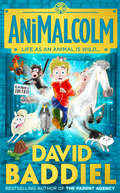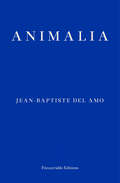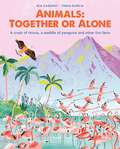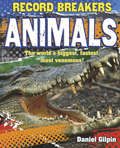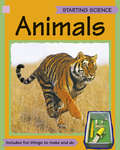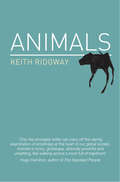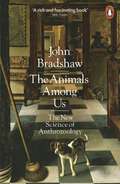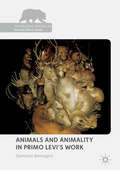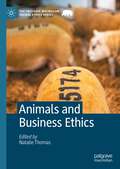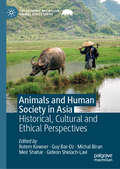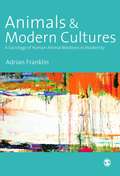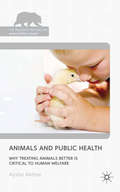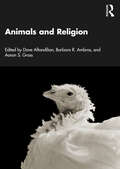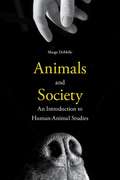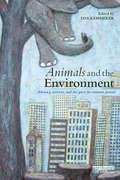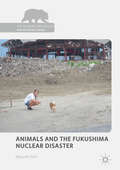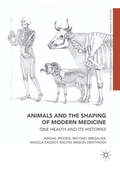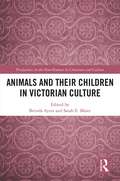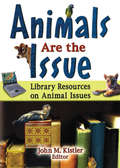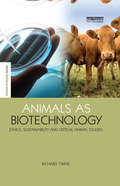- Table View
- List View
AniMalcolm: The Parent Agency; The Person Controller; Animalcolm
by David BaddielFrom David Baddiel, the brightest new star of children’s books and winner of the LOLLIES award, comes a laugh-out-loud adventure for every child who ever wondered what it might be like to be a bit of an animal…
Animalia: A Novel
by Jean-Baptiste del AmoAnimalia retraces the history of a modest peasant family through the twentieth century as they develop their small plot of land into an intensive pig farm. In an environment dominated by the omnipresence of animals, five generations endure the cataclysm of war, economic disasters, and the emergence of a brutal industrialism reflecting an ancestral tendency to violence. Only the enchanted realm of childhood – that of Éléonore, the matriarch, and that of Jérôme, the last in the lineage – and the innate freedom of the animals offer any respite from the visible barbarity of humanity. Written in shifting prose that reflects the passage of time, Animalia is a powerful novel about man’s desire to conquer nature and the transmission of violence from one generation to the next. ‘Animalia is a book about sex and violence, but it has unusual sobriety, and a story with a deep pull. The way it senses the natural world, in seed, vein, hair, grain, pore, bud, f luid, is like nothing I’ve read.’ – Daisy Hildyard, author of The Second Body
Animals: A crash of rhinos, a waddle of penguins and other fun facts
by Mia CassanySome animals need to live in big groups, although others barely interact with the rest of the herd. Do you want to know why?This book is full of colourful illustrations answering the questions of how, why and when animals decide to live in groups or alone. This useful and entertaining resource helps you discover fun facts about Flamingos, Polar Bears, Zebras, Emperor penguins and many more!
Animals: Animals Library Ebook (Record Busters #1)
by Daniel GilpinPerfect for capturing a young general reader's or an older reluctant reader's interest, these hi-lo titles feature gripping, minimal, fact-based text, dramatic and impactful pictures, and an edgy design to reveal the fastest, tallest, smallest, oldest or quirkiest!
Animals: Animal Homes (Project Science)
by Sally HewittFun, lively introductions to science with practical activities and projects to strengthen learning.
Animals
by Keith RidgwayA novel of confusion and paranoia, love and doubt, fear and hysteria: unsettling, unhinged, provocative and bestially funny, ‘Animals’ is for human beings everywhere.
The Animals Among Us: The New Science of Anthrozoology
by John Bradshaw'A pioneering study ... richly, empathetically and affectionately respectful of the human-animal bond' Sunday TimesWhy do humans love animals? The bestselling author of In Defence of Dogs and Cat Sense gives us the answers.Keeping pets is expensive, time-consuming, and seemingly irrational - so why do so many of us have an animal in our lives?Modern-day pet-keeping has been justified for many reasons, from the potential therapeutic role pets can play, to their appealing 'cuteness'. But pet-keeping is much more than just a simple pastime. It is part of the broader history of humanity's relationship with animals - a relationship that comes from deep within our nature. As John Bradshaw reveals in this highly original new work, our connection with animals is one of the very things that makes us human. In The Animals Among Us, Bradshaw takes us to the heart of Anthrozoology, a new science dedicated to discovering the true nature and depth of the human-animal bond. Following the thread of our affection for animals, from today's pet lovers all the way back to our ancient ancestors, Bradshaw reveals how animals have always been an integral part of our lives: indeed, they have shaped the evolution of our minds and our bodies. The ways in which we relate to animals today stem ultimately from our evolutionary journey from hominid to Homo sapiens.An affinity for animals drove our evolution as humans. Now, as increasing numbers of species are under threat, John Bradshaw shows us that pet-keeping can act as a bridge between the domestic and the wild, even aiding conservation. If we lose the animals among us, he warns, we risk losing an essential part of ourselves.
Animals and Animality in Primo Levi’s Work (The Palgrave Macmillan Animal Ethics Series)
by Damiano BenvegnùSituated at the intersection of animal studies and literary theory, this book explores the remarkable and subtly pervasive web of animal imagery, metaphors, and concepts in the work of the Jewish-Italian writer, chemist, and Holocaust survivor Primo Levi (1919-1987). Relatively unexamined by scholars, the complex and extensive animal imagery Levi employed in his literary works offers new insights into the aesthetical and ethical function of testimony, as well as an original perspective on contemporary debates surrounding human-animal relationships and posthumanism. The three main sections that compose the book mirror Levi’s approach to non-human animals and animality: from an unquestionable bio-ethical origin (“Suffering”); through an investigation of the relationships between writing, technology, and animality (“Techne”); to a creative intellectual project in which literary animals both counterbalance the inevitable suffering of all creatures, and suggest a transformative image of interspecific community (“Creation”).
Animals and Business Ethics (The Palgrave Macmillan Animal Ethics Series)
by Natalie ThomasThis book engages with some of the most pressing ethical issues that arise from the use of animals in various business practices, providing interdisciplinary approaches to improving the nonhuman and human lives in animal-related industries. The chapters in this volume provide conceptual, theoretical and practical analyses of these issues that will shape the future direction of business ethics to more fully refl ect the impacts and implications of animal-based businesses on society, its members, and nature. The authors in this volume engage with topics including animal suffering and emotions, the commodifi cation of animals, vegetarian and vegan businesses and diets, technological innovations such as gene editing and lab-cultured meat, as well as captivity, corporate disclosure of animal welfare policies, and the possibility of humane jobs as well as the consideration of animals as stakeholders.
Animals and Human Society in Asia: Historical, Cultural and Ethical Perspectives (The Palgrave Macmillan Animal Ethics Series)
by Rotem Kowner Michal Biran Gideon Shelach-Lavi Meir Shahar Guy Bar-OzThis edited collection offers a comprehensive overview of the different aspects of human-animal interactions in Asia throughout history. With twelve thematically-arranged chapters, this book examines the diverse roles that beasts, livestock, and fish — real and metaphorical– have played in Asian history, society, and culture. Ranging from prehistory to the present day, the authors address a wealth of topics including the domestication of animals, dietary practices and sacrifice, hunting, the use of animals in war, and the representation of animals in literature and art. Providing a unique perspective on human interaction with the environment, the volume is cross-disciplinary in its reach, offering enriching insights to the fields of animal ethics, Asian studies, world history and more.
Animals and Modern Cultures
by Adrian FranklinThe dramatic transformation of relationships between humans and animals in the 20th century are investigated in this fascinating and accessible book. At the beginning of this century these relationships were dominated by human needs and interests, modernization was a project which was attached to the goal of progress and animals were merely resources to be used on the path towards human fulfilment. These relationships are increasingly being subjected to criticism and a new field of interest in human-animal relationships has opened up. We are now urged to be more sensitive and compassionate to animal needs and interests, to understand their mindedness and how their lives and ours are entangled. This book focuses on social change and animals, it is concerned with how humans relate to animals and how this has changed and why. Moreover, it highlights, through chapters on companion animals, hunting and fishing, animal leisures such as birdwatching and wildlife parks, and the meat and livestock industries, how attitudes and practices towards animals vary widely according to social class, ethnicity, gender, region and nation.
Animals and Public Health: Why Treating Animals Better is Critical to Human Welfare (The Palgrave Macmillan Animal Ethics Series)
by A. AkhtarA compelling argument of how human health is adversely affected by our poor treatment of non-human animals. The author contents that in order to successfully confront the 21st Century's health challenges, we need to broaden the definition of the word 'public' in public health to include non-human animals.
Animals and Religion
by Dave Aftandilian Barbara R. Ambros Aaron S. GrossWhat do animals—other than human animals—have to do with religion? How do our religious ideas about animals affect the lives of real animals in the world? How can we deepen our understanding of both animals and religion by considering them together? Animals and Religion explores how animals have crucially shaped how we understand ourselves, the other living beings around us, and our relationships with them.Through incisive analyses of religious examples from around the world, the original contributions to this volume demonstrate how animals have played key roles in every known religious tradition, whether as sacred beings, symbols, objects of concern, fellow creatures, or religious teachers. And through our religious imagination, ethics, and practices, we have deeply impacted animal lives, whether by domesticating, sacrificing, dominating, eating, refraining from eating, blessing, rescuing, releasing, commemorating, or contemplating them. Drawing primarily on perspectives from religious studies and Christian theology, augmented by cutting-edge work in anthropology, biology, philosophy, and psychology, Animals and Religion offers the reader a richer understanding of who animals are and who we humans are. Do animals have emotions? Do they think or use language? Are they persons? How we answer questions like these affects diverse aspects of religion that shape not only how we relate to other animals, but also how we perceive and misperceive each other along axes of gender, race, and (dis)ability.Accessibly written and thoughtfully argued, Animals and Religion will interest anyone who wants to learn more about animals, religion, and what it means to be a human animal.
Animals and Religion
What do animals—other than human animals—have to do with religion? How do our religious ideas about animals affect the lives of real animals in the world? How can we deepen our understanding of both animals and religion by considering them together? Animals and Religion explores how animals have crucially shaped how we understand ourselves, the other living beings around us, and our relationships with them.Through incisive analyses of religious examples from around the world, the original contributions to this volume demonstrate how animals have played key roles in every known religious tradition, whether as sacred beings, symbols, objects of concern, fellow creatures, or religious teachers. And through our religious imagination, ethics, and practices, we have deeply impacted animal lives, whether by domesticating, sacrificing, dominating, eating, refraining from eating, blessing, rescuing, releasing, commemorating, or contemplating them. Drawing primarily on perspectives from religious studies and Christian theology, augmented by cutting-edge work in anthropology, biology, philosophy, and psychology, Animals and Religion offers the reader a richer understanding of who animals are and who we humans are. Do animals have emotions? Do they think or use language? Are they persons? How we answer questions like these affects diverse aspects of religion that shape not only how we relate to other animals, but also how we perceive and misperceive each other along axes of gender, race, and (dis)ability.Accessibly written and thoughtfully argued, Animals and Religion will interest anyone who wants to learn more about animals, religion, and what it means to be a human animal.
Animals And Society: An Introduction To Human-animal Studies (PDF)
by Margo DeMelloConsidering that much of human society is structured through its interaction with non-human animals, and since human society relies heavily on the exploitation of animals to serve human needs, human-animal studies has become a rapidly expanding field of research, featuring a number of distinct positions, perspectives, and theories that require nuanced explanation and contextualization. The first book to provide a full overview of human-animal studies, this volume focuses on the conceptual construction of animals in American culture and the way in which it reinforces and perpetuates hierarchical human relationships rooted in racism, sexism, and class privilege. Margo DeMello considers interactions between humans and animals within the family, the law, the religious and political system, and other major social institutions, and she unpacks the different identities humans fashion for themselves and for others through animals. Essays also cover speciesism and evolutionary continuities; the role and preservation of animals in the wild; the debate over zoos and the use of animals in sports; domestication; agricultural practices such as factory farming; vivisection; animal cruelty; animal activism; the representation of animals in literature and film; and animal ethics. Sidebars highlight contemporary controversies and issues, with recommendations for additional reading, educational films, and related websites. DeMello concludes with an analysis of major philosophical positions on human social policy and the future of human-animal relations.
Animals and the Environment: Advocacy, activism, and the quest for common ground
by Lisa KemmererContemporary Earth and animal activists rarely collaborate, perhaps because environmentalists focus on species and ecosystems, while animal advocates look to the individual, and neither seems to have much respect for the other. This diverse collection of essays highlights common ground between earth and animal advocates, most notably the protection of wildlife and personal dietary choice. If earth and animal advocates move beyond philosophical differences and resultant divergent priorities, turning attention to shared goals, both will be more effective – and both animals and the environment will benefit. Given the undeniable seriousness of the environmental problems that we face, including climate change and species extinction, it is essential that activists join forces. Drawing on a wide range of issues and disciplines, ranging from wildlife management, hunting, and the work of NGOs to ethics, ecofeminism, religion and animal welfare, this volume provides a stimulating collection of ideas and challenges for anyone else who cares about the environment or animals.
Animals and the Environment: Advocacy, activism, and the quest for common ground
by Lisa KemmererContemporary Earth and animal activists rarely collaborate, perhaps because environmentalists focus on species and ecosystems, while animal advocates look to the individual, and neither seems to have much respect for the other. This diverse collection of essays highlights common ground between earth and animal advocates, most notably the protection of wildlife and personal dietary choice. If earth and animal advocates move beyond philosophical differences and resultant divergent priorities, turning attention to shared goals, both will be more effective – and both animals and the environment will benefit. Given the undeniable seriousness of the environmental problems that we face, including climate change and species extinction, it is essential that activists join forces. Drawing on a wide range of issues and disciplines, ranging from wildlife management, hunting, and the work of NGOs to ethics, ecofeminism, religion and animal welfare, this volume provides a stimulating collection of ideas and challenges for anyone else who cares about the environment or animals.
Animals and the Fukushima Nuclear Disaster (The Palgrave Macmillan Animal Ethics Series)
by Mayumi ItohThis book is the first comprehensive, in-depth English language study of the animals that were left behind in the exclusion zone in the wake of the nuclear meltdown of three of the four reactors at the Fukushima Daiichi Nuclear Power Station in March 2011, triggered by the Great East Japan Earthquake of magnitude 9.0.The Japanese government designated an area of 20-kilometer radius from the nuclear power station as an exclusion zone and evacuated one hundred thousand residents, but left companion animals and livestock animals behind in the radioactive area. Consequently, about 90 percent of the animals in the exclusion zone died. This book juxtaposes policies of the Japanese government toward the animals in Fukushima with the actions of grassroots volunteer animal rescue groups that filled the void of the government.
Animals and the Shaping of Modern Medicine: One Health and its Histories
by Angela Cassidy Abigail Woods Michael Bresalier Rachel Mason DentingerThis book is open access under a CC BY 4.0 license.This book breaks new ground by situating animals and their diseases at the very heart of modern medicine. In demonstrating their historical significance as subjects and shapers of medicine, it offers important insights into past animal lives, and reveals that what we think of as ‘human’ medicine was in fact deeply zoological.Each chapter analyses an important episode in which animals changed and were changed by medicine. Ranging across the animal inhabitants of Britain’s zoos, sick sheep on Scottish farms, unproductive livestock in developing countries, and the tapeworms of California and Beirut, they illuminate the multi-species dimensions of modern medicine and its rich historical connections with biology, zoology, agriculture and veterinary medicine. The modern movement for One Health – whose history is also analyzed – is therefore revealed as just the latest attempt to improve health by working across species and disciplines. This book will appeal to historians of animals, science and medicine, to those involved in the promotion and practice of One Health today.
Animals and the Shaping of Modern Medicine: One Health and its Histories
by Abigail Woods Michael Bresalier Angela Cassidy Rachel Mason DentingerThis book is open access under a CC BY 4.0 license.This book breaks new ground by situating animals and their diseases at the very heart of modern medicine. In demonstrating their historical significance as subjects and shapers of medicine, it offers important insights into past animal lives, and reveals that what we think of as ‘human’ medicine was in fact deeply zoological.Each chapter analyses an important episode in which animals changed and were changed by medicine. Ranging across the animal inhabitants of Britain’s zoos, sick sheep on Scottish farms, unproductive livestock in developing countries, and the tapeworms of California and Beirut, they illuminate the multi-species dimensions of modern medicine and its rich historical connections with biology, zoology, agriculture and veterinary medicine. The modern movement for One Health – whose history is also analyzed – is therefore revealed as just the latest attempt to improve health by working across species and disciplines. This book will appeal to historians of animals, science and medicine, to those involved in the promotion and practice of One Health today.
Animals and Their Children in Victorian Culture (Perspectives on the Non-Human in Literature and Culture)
by Brenda Ayres Sarah Elizabeth MaierWhether a secularized morality, biblical worldview, or unstated set of mores, the Victorian period can and always will be distinguished from those before and after for its pervasive sense of the "proper way" of thinking, speaking, doing, and acting. Animals in literature taught Victorian children how to be behave. If you are a postmodern posthumanist, you might argue, "But the animals in literature did not write their own accounts." Animal characters may be the creations of writers’ imagination, but animals did and do exist in their own right, as did and do humans. The original essays in Animals and Their Children in Victorian explore the representation of animals in children’s literature by resisting an anthropomorphized perception of them. Instead of focusing on the domestication of animals, this book analyzes how animals in literature "civilize" children, teaching them how to get along with fellow creatures—both human and nonhuman.
Animals and Their Children in Victorian Culture (Perspectives on the Non-Human in Literature and Culture)
by Brenda Ayres Sarah Elizabeth MaierWhether a secularized morality, biblical worldview, or unstated set of mores, the Victorian period can and always will be distinguished from those before and after for its pervasive sense of the "proper way" of thinking, speaking, doing, and acting. Animals in literature taught Victorian children how to be behave. If you are a postmodern posthumanist, you might argue, "But the animals in literature did not write their own accounts." Animal characters may be the creations of writers’ imagination, but animals did and do exist in their own right, as did and do humans. The original essays in Animals and Their Children in Victorian explore the representation of animals in children’s literature by resisting an anthropomorphized perception of them. Instead of focusing on the domestication of animals, this book analyzes how animals in literature "civilize" children, teaching them how to get along with fellow creatures—both human and nonhuman.
Animals are the Issue: Library Resources on Animal Issues
by Linda S KatzSupply your library with the best collection of resources on animal issues! Animals are the Issue: Library Resources on Animal Issues is a guide to books, journals, and Web sites on historic and modern animal treatment. Expert librarians and scholars provide helpful resources showing what ideals and practical solutions exist in animal rights and welfare debates. With this book, students, philosophers, and politicians can find the best of written and electronic resources about the protection and ethical use of animals by humankind. Animals are the Issue stands alone as a source for locating materials on animal protection and welfare. This valuable guide will help librarians save time and money in locating diverse areas of information regarding animal consumption and exploitation. The authors have noted what they consider to be the most essential resources for library collections. This book offers references that discuss the utilization of animals by humans: as companions in sports and entertainment in religion in science and education in industry in hunting Animals Are the Issue explores how animals are seen, viewed, and used by humans. With bibliographies, annotated lists, and short commentaries by the authors on nearly every item, you&’ll be able to supply your patrons with a highly effective animal rights/welfare collection.
Animals are the Issue: Library Resources on Animal Issues
by Linda S KatzSupply your library with the best collection of resources on animal issues! Animals are the Issue: Library Resources on Animal Issues is a guide to books, journals, and Web sites on historic and modern animal treatment. Expert librarians and scholars provide helpful resources showing what ideals and practical solutions exist in animal rights and welfare debates. With this book, students, philosophers, and politicians can find the best of written and electronic resources about the protection and ethical use of animals by humankind. Animals are the Issue stands alone as a source for locating materials on animal protection and welfare. This valuable guide will help librarians save time and money in locating diverse areas of information regarding animal consumption and exploitation. The authors have noted what they consider to be the most essential resources for library collections. This book offers references that discuss the utilization of animals by humans: as companions in sports and entertainment in religion in science and education in industry in hunting Animals Are the Issue explores how animals are seen, viewed, and used by humans. With bibliographies, annotated lists, and short commentaries by the authors on nearly every item, you&’ll be able to supply your patrons with a highly effective animal rights/welfare collection.
Animals as Biotechnology: "Ethics, Sustainability and Critical Animal Studies"
by Richard TwineIn Animals as Biotechnology sociologist Richard Twine places the question of human/animal relations at the heart of sustainability and climate change debates. The book is shaped by the emergence of two contradictory trends within our approach to nonhuman animals: the biotechnological turn in animal sciences, which aims to increase the efficiency and profitability of meat and dairy production; and the emerging field of critical animal studies - mostly in the humanities and social sciences - which works to question the nature of our relations with other animals. The first part of the book focuses on ethics, examining critically the dominant paradigms of bioethics and power relations between human and non-human. The second part considers animal biotechnology and political economy, examining commercialisation and regulation. The final part of the book centres on discussions of sustainability, limits and an examination of the prospects for animal ethics if biotechnology becomes part of the dominant agricultural paradigm. Twine concludes by considering whether growing calls to reduce our consumption of meat/dairy products in the face of climate change threats are in fact complicit with an anthropocentric understanding of sustainability and that what is needed is a more fundamental ethical and political questioning of relations and distinctions between humans, animals and nature.
